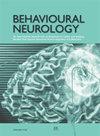临床定义帕金森病的神经精神症状:最新文献综述
IF 2.3
4区 医学
Q2 CLINICAL NEUROLOGY
引用次数: 6
摘要
背景神经精神症状(NPS)是帕金森病(PD)的一种常见且潜在的严重表现,但经常被忽视,而倾向于关注运动症状学。在这里,我们对具有临床定义病程的帕金森病患者所经历的NPS的患病率和类型进行了文献综述。方法我们确定了帕金森病患者的NPS报告和3年以上的平均病程。检索了PubMed、Scopus和Dialnet三个数据库,以查找2010年至2020年间发表的相关文献。在对文献基础进行描述性分析之前,应用预定义的排除标准。结果共发现87份独特的报告,其中30份符合纳入和排除标准。其中7142名PD患者(男性:67.3%;平均年龄:66.2岁;平均病程:6.7年)。最常见的NPS是情绪障碍(冷漠、抑郁和焦虑)、精神病和冲动控制障碍(ICD)。多巴胺激动剂治疗被确定为ICD的一个重要危险因素。NPS和认知功能障碍的共同发生也在许多研究中得到证实。具有更显著认知缺陷和更高NPS水平的患者年龄较大,病程较长,运动症状更严重。结论NPS,最常见的情绪障碍(冷漠、抑郁和焦虑)、精神病和ICD是帕金森病的常见表现。本综述的结果反映了制定统一、有效的帕金森病NPS评估方案的必要性,并在临床实践中改进其管理。本文章由计算机程序翻译,如有差异,请以英文原文为准。
Neuropsychiatric Symptoms in Clinically Defined Parkinson's Disease: An Updated Review of Literature
Background Neuropsychiatric symptoms (NPS) are a common and potentially serious manifestation of Parkinson's disease (PD) but are frequently overlooked in favor of a focus on motor symptomatology. Here, we conducted a literature review of the prevalence and type of NPS experienced by PD patients with a clinically defined course of their illness. Methods We identified reports of NPS in patients with PD and mean disease duration over 3 years. Three databases—PubMed, Scopus, and Dialnet—were searched for relevant literature published between 2010 and 2020. Predefined exclusion criteria were applied prior to a descriptive analysis of the literature base. Results In all, 87 unique reports were identified and 30 met inclusion and exclusion criteria. These included 7142 patients with PD (male: 67.3%; mean age: 66.2 years; mean disease duration: 6.7 years). The most frequent NPS were mood disorders (apathy, depression, and anxiety), psychosis, and impulse control disorders (ICD). Treatment with dopamine agonists was identified as an important risk factor for ICD. Co-occurrence of NPS and cognitive dysfunction was also evidenced in a number of studies. Patients with more significant cognitive deficits and higher levels of NPS appeared to be of older age with a longer disease duration and to have more severe motor symptoms. Conclusions NPS, most commonly mood disorders (apathy, depression, and anxiety), psychosis, and ICDs are frequent manifestations of PD. The results of this review reflect the need to develop unified validated assessment protocols for NPS in PD, as well as to improve their management in clinical practice.
求助全文
通过发布文献求助,成功后即可免费获取论文全文。
去求助
来源期刊

Behavioural Neurology
医学-临床神经学
CiteScore
5.40
自引率
3.60%
发文量
52
审稿时长
>12 weeks
期刊介绍:
Behavioural Neurology is a peer-reviewed, Open Access journal which publishes original research articles, review articles and clinical studies based on various diseases and syndromes in behavioural neurology. The aim of the journal is to provide a platform for researchers and clinicians working in various fields of neurology including cognitive neuroscience, neuropsychology and neuropsychiatry.
Topics of interest include:
ADHD
Aphasia
Autism
Alzheimer’s Disease
Behavioural Disorders
Dementia
Epilepsy
Multiple Sclerosis
Parkinson’s Disease
Psychosis
Stroke
Traumatic brain injury.
 求助内容:
求助内容: 应助结果提醒方式:
应助结果提醒方式:


